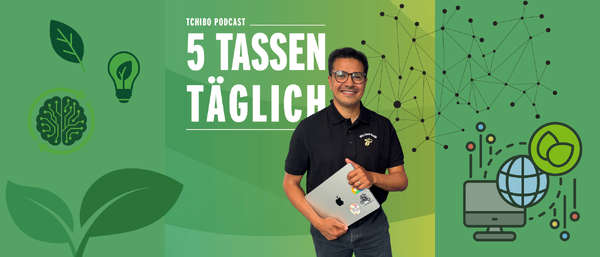
#123 How much latte macchiato does AI need?
In this podcast episode of 5 cups a day, Ralf Podszus talks to Tchibo AI boss Omar Hairani about the ecological light and dark sides of technology: How big is the footprint of ChatGPT & Co. Can AI use its computing power to protect the environment? And how is Tchibo dealing with the issue?
We keep hearing that AI consumes an incredible amount of electricity and swallows water without end. We did the maths on a coffee scale during our AI deployment at Tchibo. And we're relieved: we use just as much electricity for the common AI tools in the house as a professional barista machine does in a year. So it's within reasonable limits. However, the global picture is different, which raises the question: is artificial intelligence a climate monster or an environmental saviour?

There is a lot on the negative list: AI consumes huge amounts of electricity, devours masses of water and uses up valuable raw materials. BUT: At the same time, artificial intelligence can help us massively with environmental protection! In agriculture, for example, it can combat pests without pesticides (hey with mini drones and laser beams!), it can store energy more efficiently and help to save CO₂.
An hour of facts, aha moments - and a few surprising answers. Or did you know that China produces as much renewable energy in Mongolia as the rest of the world combined? And that's just to feed the Chinese AI! Or did you know that a chat GPT request consumes half a litre of water? And as much energy as 100 Google questions put together?
Our guest, Omar Hairani, Head of AI at Tchibo, emphasises the enormous challenges and opportunities of artificial intelligence: "The technology consumes huge amounts of energy, water and raw materials. At the same time, it opens up enormous opportunities in environmental protection, medicine and agriculture. In the new podcast episode, Omar explains why Tchibo measures its own AI footprint precisely and how the company consciously uses models in an energy-efficient way.
We talk about:
- the real energy and water consumption of ChatGPT & Co. and why the providers' official figures are often falsified
- the construction of new nuclear power plants in the USA and the enormous consumption of resources, from rare metals to growing electronic waste
- the ecological consequences of hardware production, such as high environmental costs in the supply chains and problems caused by waste heat and water heating
As well as the positive sides of AI:
- Agriculture without pesticides, how mini-drones control pests with lasers
- Medical advances, from new antibiotics to the reliable early detection of diseases using AI
- Conserving resources through intelligent logistics and more efficient goods distribution at Tchibo
"In the last two years, 400,000 new materials have been discovered through AI alone. That's a huge number, that's 45 times more than humanity has discovered in its entire existence, through AI." Omar Hairani
"We also came up with precise calculations for the electricity, which showed that we have roughly the same additional power consumption as a professional barista machine that also runs in a restaurant or coffee bar in normal operation." Omar Hairani
"There is an infinite number of possibilities in medicine, in prevention, in the fight against cancer, in all other diseases. ... People who previously couldn't walk or couldn't hear can suddenly hear. All thanks to AI. So the examples are endless." Omar Hairani
Find out which request consumes less power, Chat GPT or Google? Have a listen!
